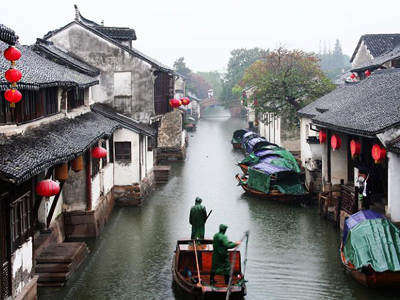Suzhou- The Town
The city of Suzhou is one of the most beautiful and I think overlooked parts of China. There is so much on offer and really gives the best of both worlds- ancient gardens and temples only minutes away from heavily built up city areas.
Suzhou (sometimes spelt ‘Soochow’) was founded in 514 BC and used to be an important centre for the silk trade in China. It is home to some of the oldest pagodas and canals in China, and is part of the UNESCO World Heritage Sites list.
It is found in the Yangzi River Basin, Jiangsu province, about a two hour drive from Shanghai. The dialect in Suzhou is said to one of the most lovely in China- I read in a tourist guide that ‘an argument in Suzhou sounds more beautiful than flattery in Beijing’.
What to see
In Suzhou there is a wide range of tourist spots to suit every interest. It is highly recommended that you visit the Humble Administrators Garden, which provided the blueprint of style of quality for nearly every Chinese garden that followed. Although the garden is beautiful, it is normally hugely crowded, so you may enjoy the smaller gardens dotted around nearby.
Mudu is a beautiful ancient river town a bus ride out of town. It is filled with great shopping spots and an old canal running right through, which you can take a boat trip down until late evening. Another beautiful tourist spot is Tiger Hill, home to the Cloud Pavillion (an ancient leaning pagoda). This attraction is easily one of the most beautiful and entertaining places in Suzhou, and although normally very busy, it is easy to escape into the rolling grounds surrounding the hill.
In complete contrast to these ancient landmarks is the Suzhou Industrial Park (SIP), which is a fairly long bus ride away to the South of town. This concrete ‘lawn’ stretches around a large lake, and is home to hundreds of stalls, big Western restaurants and evening activities, such as roller-skating and setting off Chinese lanterns. Every Friday and Saturday evening, the park hosts a half hour long water display, using huge fountains lit up with colour changing lasers set to a musical background.
How to travel
Walking: It’s a good idea to buy a map of the area you are staying in to familiarise yourself with your surroundings. There are normally public amenities like shops, massage parlours etc within close walking distance in any built up area, so walking is a good option.
Buses: The bus system is pretty good in Suzhou, although none of the information is in English so you will have to ask your supervisor within the school for the simplest bus routes. It costs 1 yuan per bus journey, or 2 yuan if you are travelling on an air-conditioned bus (which has a green star on the front). Where I was, (the Suzhou Foreign Language School) the number 2 bus took us straight into the centre of town, whilst the 68 took us further south to the Industrial Park.
Taxi: There are no taxi ranks in Suzhou, so the only way to hail a cab is to stand at the side of the road in a safe position and wave. Their price system is good- usually 10yuan for the first 10km, and a further 2yuan per extra km.
Taxis come in many different colours, representing a different company. Turquoise, Blue and then Gold coloured taxis are the most reliable, but overall they are generally very well run. Always remember to take your receipt from your taxi driver, just in case you leave something valuable inside by accident.
High Speed Train: If you decide to travel outside Suzhou you will no doubt consider using the Maglev trains. They are incredibly fast and good value for money- a trip to Shanghai from Suzhou costs around 40 yuan each way. You will need to get a taxi to Suzhou Train Station. Remember to buy your ticket from outside the station, because none are sold in the interior waiting areas (that could have saved us a good half hour). You can buy train tickets in advance from certain shops/supermarkets, but check this first.
Metro: Depending on where you go in China, you may encounter a subway system. This information applies particularly to the Shanghai metro. The entrance to the subway is well signposted, and there is a helpful information desk with English speakers, who can provide you with a subway map and mark out your route for you if you wish. All the stations are written in Pinyin so it is fairly easy to understand. You can buy metro tickets either from stands or automatic machines- try and have the exact money available for these.
Outside Suzhou
What with Shanghai being only a half hour away from Suzhou on the high speed train, it is well worth using any free time you may have to visit.
It is a good idea to look online and book a place in a hostel before your visit, ideally in the centre town so it is easy to see as much as possible in your time there. Good sites to look for are:
www.hostelbookers.com
www.hostelworld.com/shanghai
By Rosie Welch


Leave A Comment
You must be logged in to post a comment.